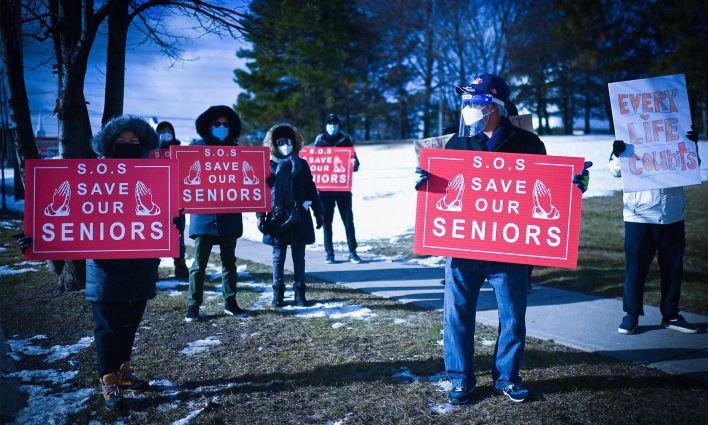In the lexicon of immigrant settlement services, the term "survival jobs" is used to signal temporary employment intended to ensure survival in the short term, and increasingly framed as an advantage to earn Canadian experience, practice and improve English language skill, and build local networks.
Reflective of labour market stratification and exclusions, “survival jobs” are most easily accessed in sectors where the pay is low, hours are part time, and formal protections are limited.
As a result, migrants and immigrants find themselves disproportionately employed in low-wage care work, food production and provisioning, cleaning and sanitation, retail, service, and hospitality.
In the context of COVID-19, many of these jobs, which are concentrated in feminized sectors, were re-designated as "essential". This shift, however, has largely been rhetorical, with only nominal improvements made to working conditions and wages. Consequently, the feminized and devalued character of these labour sectors has persisted.
Between 2022 and 2023, our research team interviewed 27 migrant and immigrant women working in sectors that were deemed essential to “flatten the curve” of spread of the virus. We asked them about their work experiences in Nova Scotia during the early days of the pandemic.
At the start of the pandemic, they were working in the care sector, in food production and provisioning, in hospitality, and the immigration and settlement sectors. They had degrees in nursing, social work, psychology, history, arts, law, engineering, IT, and education. Most women worked across three essential sectors as cleaners, food retail workers, and caregivers in both long-term care and home care.
To address population decline and its impact on economic well-being, the province has aggressively promoted immigration through new pathways for permanent residency, notably the province’s Nominee Program and the federally managed Atlantic Immigration Program.
Importantly, these programs also intersect with Canada’s Temporary Foreign Worker Program to facilitate permanent residency for qualifying migrant workers. As a result, the last five years have seen higher than typical rates of immigration to the province.
Despite the restriction of movement across borders during the pandemic, Nova Scotia registered an unprecedented number of approved applications from qualified skilled immigrants in the sectors deemed essential.
It is important to note that while support for immigration has increased, the social and economic integration of immigrant workers remains stratified, with many newcomers—our participants amongst them—working in precarious, low-wage employment in essential sectors.
Such employment renders newcomers particularly vulnerable to social and economic insecurity. Indeed, Nova Scotia’s cost of living has increased, rental prices have soared, and food and utility inflation have made these basic necessities inaccessible for many Nova Scotians.
This new reality is further compounded by government divestment from social services, which is a constant feature of the Nova Scotian political economy but has accelerated in the last five years.
These features of current-day life in the province converge with capitalism’s externalization and devaluation of reproductive labour, which, for many, came to a head during the early years of the COVID-19 pandemic. In turn, as this study corroborates, immigrant women have become key contributors to the social reproductive activities of Nova Scotian families.
Regardless of immigration pathway, the women in the study spoke of their migration as part of a larger familial project of care, social mobility, and new opportunities. Most of the women, irrespective of age or length of time in Canada, continued to provide support for family and community in the country of origin during the pandemic.
Our study highlights the contributions that immigrant and migrant women make to the socio-economic health and well-being of Nova Scotians. It also reveals their experiences of employment precarity and stratification by immigrant status as well as the link between employment precarity in essential sectors and mental health—a social and political determinant of health.
Critically, with only rare exceptions, the women held post-secondary credentials and most had considerable experience in their fields of study. Prior to COVID-19, all the women had experienced racism and discrimination both as they looked for work and once they found it.
“Working as a continuing care assistant, you are a minimum wage earner,” said one participant. “My husband was studying, and so he was only allowed to work 20 hours a week... It was the lowest time of my life. In the Middle East, I worked as a nurse and we—I'm not bragging about it—but we were not living paycheque to paycheque.
“When we landed in Canada, we exhausted everything—all of our savings—and so I needed to get a survival job. I needed to do double or triple the job; it was really hard—to the point of it affecting my mental health. So, on top of working as a health care worker, I was cleaning houses just to survive.”
These working conditions persisted and worsened in the context of COVID-19 as they became responsible for enforcing public health restrictions with an often-hostile public. While many of the women, from different vantage points, expressed gratitude for the opportunity to work in the service of people and community during the pandemic, their more positive feelings were often overshadowed by heightened isolation, anxiety, and concern for their clients and their own families.
While some of the women experienced a decrease in working hours, most felt their workload increase during the pandemic. For some, this was accompanied by additional pay, but for many, it was not. In some instances, this additional workload emerged from the need to enforce public health regulations around masking and social distancing, but in others, it was the result of reduced personnel.
“The reduction in customers meant low profits, and so I was always at risk of losing my job,” said a participant. “My co-workers were sent home, you know, to reduce the number of employees, and then my salary was reduced because there was less profit.”
Staff shortages were, at times, the result of workers resigning because they felt unsafe. In most instances, and particularly for those in food services, it was the result of diminished profit, prompting employers to reduce hours.
During the early period of the pandemic, many of the women struggled to make ends meet. This was exacerbated by an inability to access sick pay, even when they had contracted COVID-19. Each participant spoke about the toll the pandemic took on their mental health and well-being, both physically and emotionally.
“[At times], it became more than [about the physical risk of COVID], the psychological environment was just really hard,” said a participant. “A lot of [my co-workers] had never experienced anything like that or confrontations [like] in that situation; it was really hard for them to manage it. I am talking about women; most of them were women, and they were really sick. But the sickness wasn’t just related to COVID infection, it was the stress.”
In the months following the COVID-19 economic shutdown, the women struggled to recuperate. For many, the rapid acceleration of food prices, housing costs, and other expenses has been impossible to manage, given the lingering effects of the pandemic.
Indeed, the lack of affordability that increasingly characterizes life in Nova Scotia has meant that their Canadian earnings (so highly sought after by many) don’t stretch nearly far enough. A full and just economic recovery remains elusive for most.
Solutions to the longstanding and financially lucrative organization of essential labour, however, need to take seriously the implications of legal status, as well the histories and experiences of migration of essential workers.
Indeed, much of the sector's profitability follows from the perceived legitimacy of labour market stratification based on immigration status. It also follows from the perception that newcomers, temporary and permanent alike, lack the skills required for different kinds of employment.
This is fundamentally untrue, which was revealed in both the education attainment and previous employment experiences of those we interviewed. Despite their training and education, several women that we interviewed turned to child care work upon realizing that, relative to their advanced post-secondary degrees, their skills as mothers and caregivers would be much more discernable to prospective employers.
Despite the celebration of essential and frontline workers as heroes, they faced ongoing discrimination and renewed hostility from those they served, in addition to a heightened risk of COVID-19 infection. Through it all, with the burden of care and other forms of reproductive labour squarely on their shoulders, they remained steadfast in their work, ensuring, in many ways, our collective survival.







